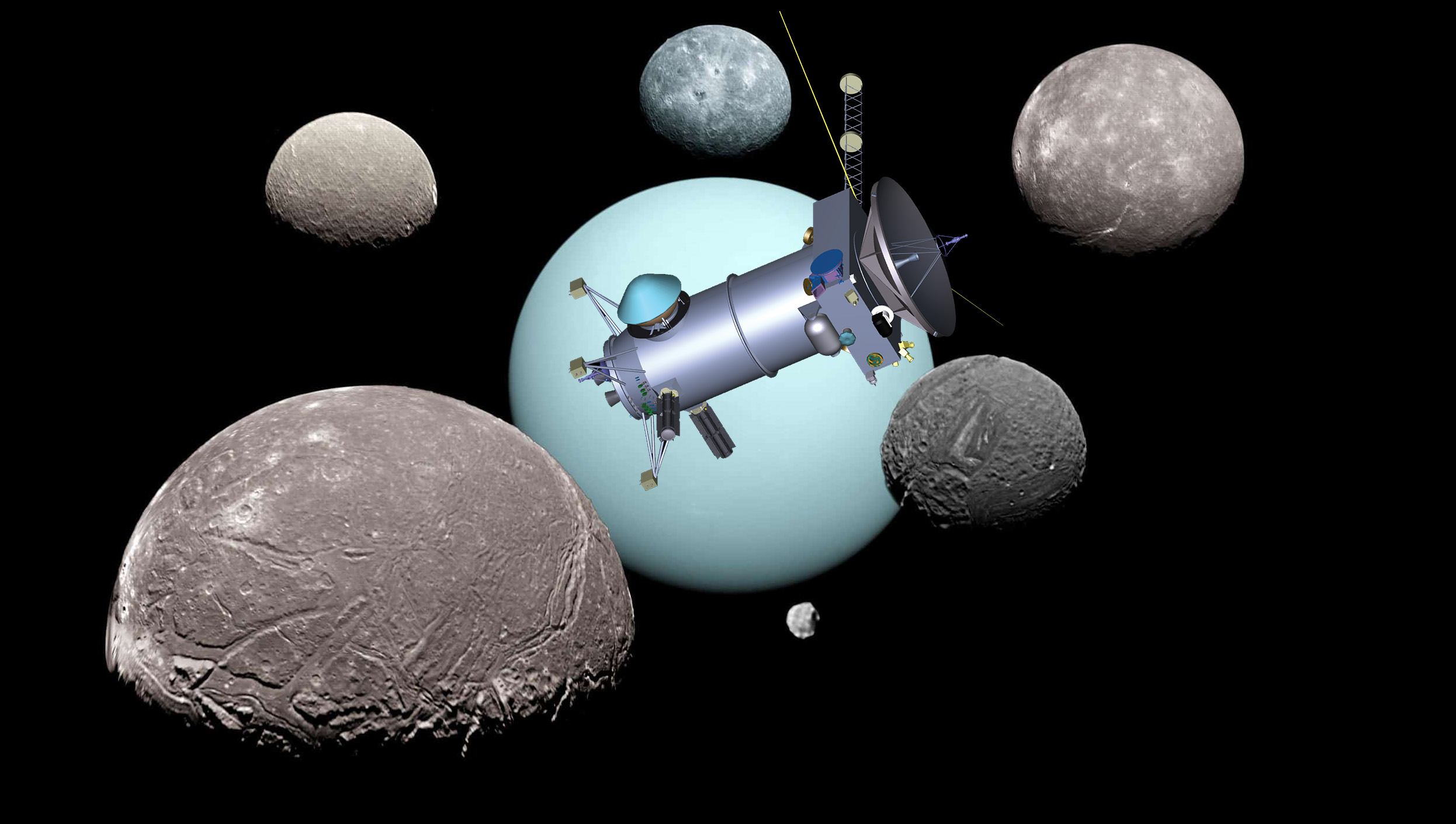
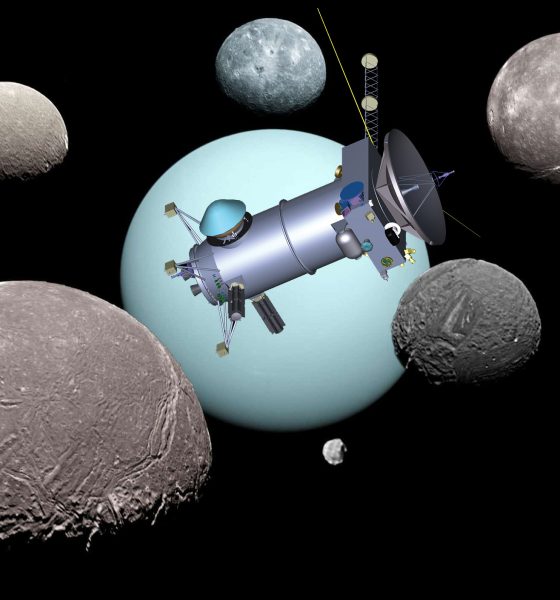
News
SpaceX-launched Uranus mission a top priority of new decadal survey
The National Academies of Sciences, Engineering, and Medicine have published their latest decadal survey of planetary science and astrobiology, revealing a recommendation that NASA prioritize the development of a flagship mission to Uranus baselined to launch on SpaceX’s Falcon Heavy rocket.
Known as the Uranus Orbiter and Probe or UOP, the mission proposal has been under development by a team of NASA, University of California, and Johns Hopkins University scientists and engineers for several years. In fact, a very similar concept ranked third in the Academies’ 2013-2022 decadal survey flagship recommendations, reiterating its central importance and potential value in the eyes of the survey’s dozens of contributors. According to its creators, in its latest iteration, the Uranus Orbiter and Probe have the potential to fully or partially answer 11 of the 12 primary questions the latest Decadal Survey structured itself around.
Additionally, the survey indirectly states that if it weren’t for the existence of one specific technology, it would have been a wash between a mission to Uranus or Neptune. That keystone: SpaceX’s Falcon Heavy rocket.
While the survey’s authors don’t explicitly point to SpaceX in the context of UOP, they do state that “a Uranus mission is favored because an end-to-end mission concept exists that can be implemented in the 2023-2032 decade on currently available launch vehicles.” In reality, there only appears to be one launch vehicle: Falcon Heavy. Three other alternatives do technically exist: United Launch Alliance’s (ULA) Vulcan Centaur, Blue Origin’s New Glenn, and NASA’s own Space Launch System (SLS).
NASA’s Europa Clipper orbiter – originally manifested on SLS but later moved to SpaceX’s Falcon Heavy to avoid major launch delays – has helped demonstrate that SLS isn’t viable for non-Artemis Program missions without massive production improvements and significant workarounds or design changes. While capable in many regards, Blue Origin’s reusable New Glenn rocket appears to have extremely poor performance beyond Earth orbit – well below what UOP requires – and is unlikely to launch before 2024 or 2025. It’s possible that an expendable New Glenn could suffice but Blue Origin has never mentioned the option and, even then, the rocket’s expendable performance could still fall short.
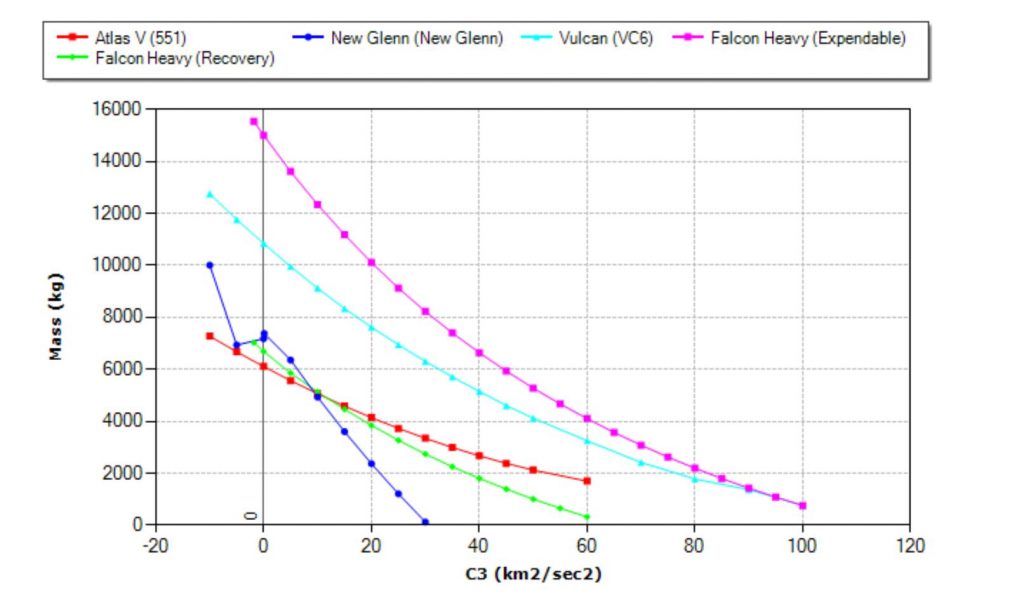
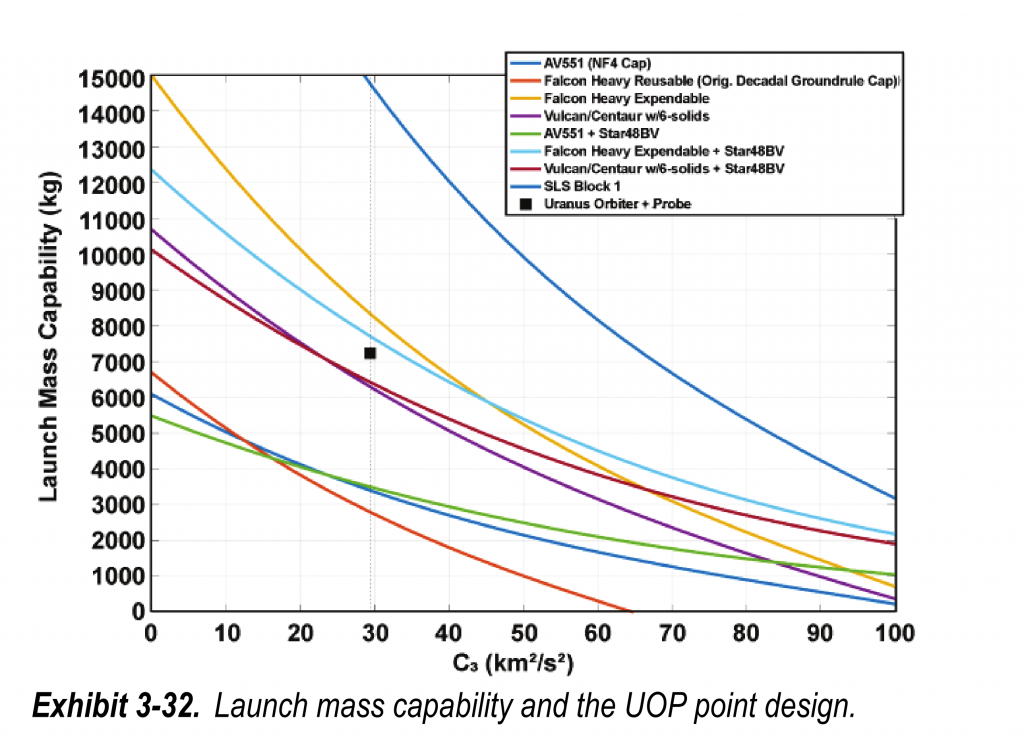
Finally, ULA’s expendable Vulcan Centaur rocket has yet to launch and its debut could easily slip into 2023. More importantly, according to official information provided by the company to a NASA-run performance calculator, even Vulcan’s most capable variant (VC6) with six solid rocket boosters (SRBs) simply doesn’t have the performance required to launch the Uranus Orbiter and Probe (7235 kg / 15,950 lb) on seven of the mission’s preferred trajectories. For three other secondary windows, Vulcan could potentially launch UOP but only with the inclusion of a Venus gravity assist that would require significant design changes to protect the spacecraft while traveling much closer to the sun.
According to NASA’s calculator, a fully-expendable Falcon Heavy rocket with a standard payload fairing could launch around 8.5-10 tons (18,700-22,000 lb) to UOP’s preferred trajectories, leaving a very healthy margin for spacecraft weight gain or launch underperformance and likely enabling a longer launch window for each opportunity.
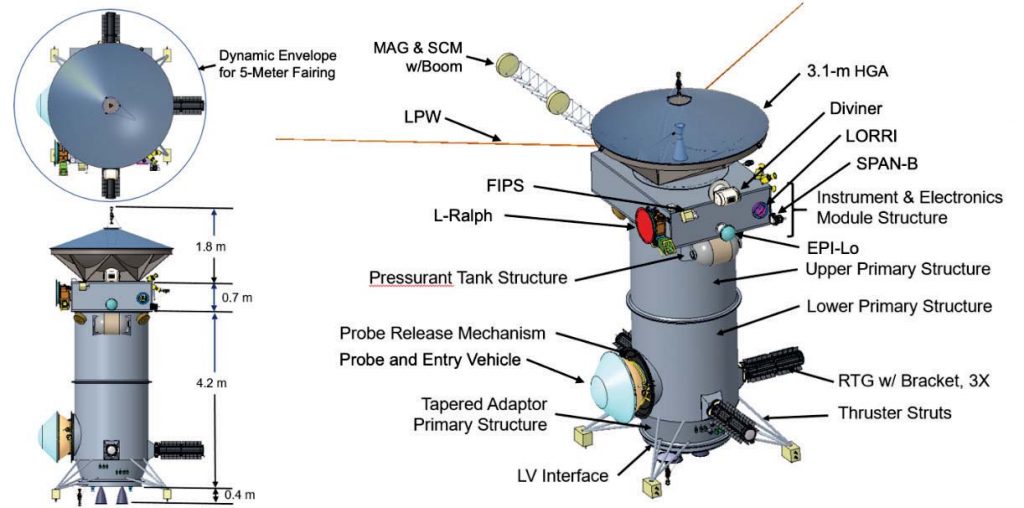
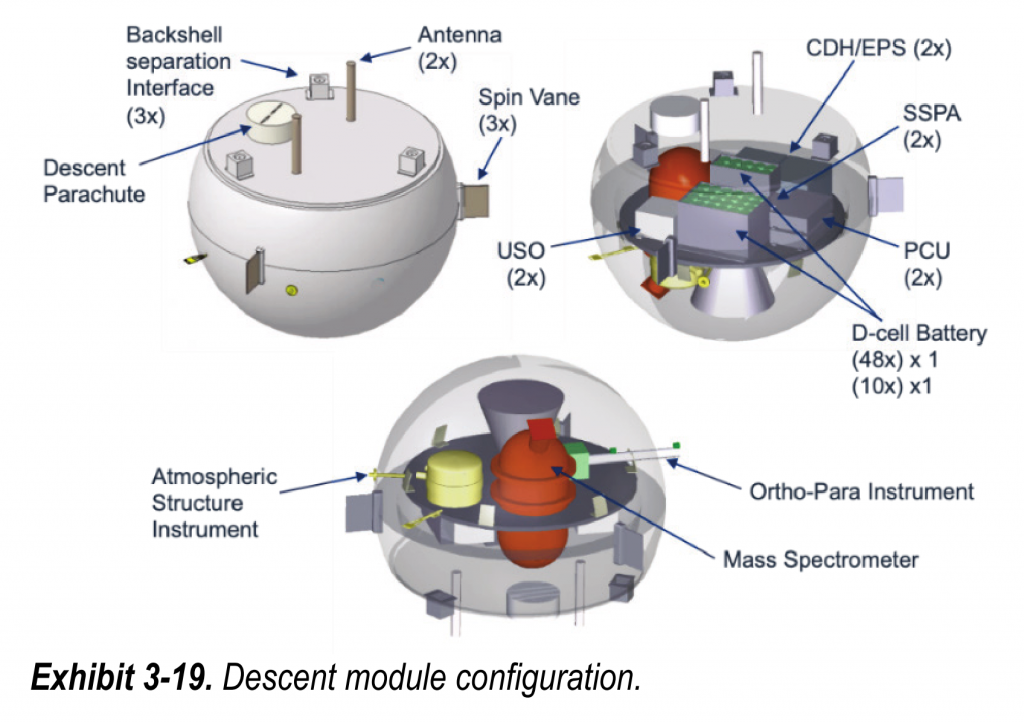
If NASA agrees with the survey’s conclusions, decides to develop the Uranus Orbiter and Probe, and also plans on the Academies’ optimistic assumption of an ~18% budget increase on average from 2023 to 2032, work towards a preferred 2031 launch window could begin in earnest as early as 2024. Comprised of a namesake Orbiter and Probe, UOP would arrive in orbit around Uranus in late 2044 or early 2045 weighing around five metric tons (~11,000 lb). The primary science mission would begin by deploying a small atmospheric probe to directly analyze the composition and behavior of the planet’s exotic atmosphere, which is believed to be volatile, prone to vast and violent storms, and host to some of the most extreme winds in the solar system. The probe would weigh ~270 kilograms (~600 lb) and is only expected to survive for a few hours at most.
The orbiter, however, would continue on to tour the Uranian system for at least four years, observing and studying the ice giant and its rings, magnetosphere, and 27+ moons. Uranus itself resides in what may be the most common class of exoplanets in the universe, making a close study of it invaluable for exoplanet science as a whole. It’s also possible that – like several moons around Saturn and Jupiter – one or more Uranian moons have liquid water oceans created by tidal heating, adding to the list of extraterrestrial bodies that might feature habitable environments or alien life.

Elon Musk
Elon Musk’s X will start using a Tesla-like software update strategy
The initiative seems designed to accelerate updates to the social media platform, while maintaining maximum transparency.

Elon Musk’s social media platform X will adopt a Tesla-esque approach to software updates for its algorithm.
The initiative seems designed to accelerate updates to the social media platform, while maintaining maximum transparency.
X’s updates to its updates
As per Musk in a post on X, the social media company will be making a new algorithm to determine what organic and advertising posts are recommended to users. These updates would then be repeated every four weeks.
“We will make the new 𝕏 algorithm, including all code used to determine what organic and advertising posts are recommended to users, open source in 7 days. This will be repeated every 4 weeks, with comprehensive developer notes, to help you understand what changed,” Musk wrote in his post.
The initiative somewhat mirrors Tesla’s over-the-air update model, where vehicle software is regularly refined and pushed to users with detailed release notes. This should allow users to better understand the details of X’s every update and foster a healthy feedback loop for the social media platform.
xAI and X
X, formerly Twitter, has been acquired by Elon Musk’s artificial intelligence startup, xAI last year. Since then, xAI has seen a rapid rise in valuation. Following the company’s the company’s upsized $20 billion Series E funding round, estimates now suggest that xAI is worth tens about $230 to $235 billion. That’s several times larger than Tesla when Elon Musk received his controversial 2018 CEO Performance Award.
As per xAI, the Series E funding round attracted a diverse group of investors, including Valor Equity Partners, Stepstone Group, Fidelity Management & Research Company, Qatar Investment Authority, MGX, and Baron Capital Group, among others. Strategic partners NVIDIA and Cisco Investments also continued support for building the world’s largest GPU clusters.
News
Tesla FSD Supervised wins MotorTrend’s Best Driver Assistance Award
The decision marks a notable reversal for the publication from prior years, with judges citing major real-world improvements that pushed Tesla’s latest FSD software ahead of every competing ADAS system.

Tesla’s Full Self-Driving (Supervised) system has been named the best driver-assistance technology on the market, earning top honors at the 2026 MotorTrend Best Tech Awards.
The decision marks a notable reversal for the publication from prior years, with judges citing major real-world improvements that pushed Tesla’s latest FSD software ahead of every competing ADAS system. And it wasn’t even close.
MotorTrend reverses course
MotorTrend awarded Tesla FSD (Supervised) its 2026 Best Tech Driver Assistance title after extensive testing of the latest v14 software. The publication acknowledged that it had previously criticized earlier versions of FSD for erratic behavior and near-miss incidents, ultimately favoring rivals such as GM’s Super Cruise in earlier evaluations.
According to MotorTrend, the newest iteration of FSD resolved many of those shortcomings. Testers said v14 showed far smoother behavior in complex urban scenarios, including unprotected left turns, traffic circles, emergency vehicles, and dense city streets. While the system still requires constant driver supervision, judges concluded that no other advanced driver-assistance system currently matches its breadth of capability.
Unlike rival systems that rely on combinations of cameras, radar, lidar, and mapped highways, Tesla’s FSD operates using a camera-only approach and is capable of driving on city streets, rural roads, and freeways. MotorTrend stated that pure utility, the ability to handle nearly all road types, ultimately separated FSD from competitors like Ford BlueCruise, GM Super Cruise, and BMW’s Highway Assistant.
High cost and high capability
MotorTrend also addressed FSD’s pricing, which remains significantly higher than rival systems. Tesla currently charges $8,000 for a one-time purchase or $99 per month for a subscription, compared with far lower upfront and subscription costs from other automakers. The publication noted that the premium is justified given FSD’s unmatched scope and continuous software evolution.
Safety remained a central focus of the evaluation. While testers reported collision-free operation over thousands of miles, they noted ongoing concerns around FSD’s configurable driving modes, including options that allow aggressive driving and speeds beyond posted limits. MotorTrend emphasized that, like all Level 2 systems, FSD still depends on a fully attentive human driver at all times.
Despite those caveats, the publication concluded that Tesla’s rapid software progress fundamentally reshaped the competitive landscape. For drivers seeking the most capable hands-on driver-assistance system available today, MotorTrend concluded Tesla FSD (Supervised) now stands alone at the top.
News
Elon Musk’s Grokipedia surges to 5.6M articles, almost 79% of English Wikipedia
The explosive growth marks a major milestone for the AI-powered online encyclopedia, which was launched by Elon Musk’s xAI just months ago.

Elon Musk’s Grokipedia has grown to an impressive 5,615,201 articles as of today, closing in on 79% of the English Wikipedia’s current total of 7,119,376 articles.
The explosive growth marks a major milestone for the AI-powered online encyclopedia, which was launched by Elon Musk’s xAI just months ago. Needless to say, it would only be a matter of time before Grokipedia exceeds English Wikipedia in sheer volume.
Grokipedia’s rapid growth
xAI’s vision for Grokipedia emphasizes neutrality, while Grok’s reasoning capabilities allow for fast drafting and fact-checking. When Elon Musk announced the initiative in late September 2025, he noted that Grokipedia would be an improvement to Wikipedia because it would be designed to avoid bias.
At the time, Musk noted that Grokipedia “is a necessary step towards the xAI goal of understanding the Universe.”
Grokipedia was launched in late October, and while xAI was careful to list it only as Version 0.1 at the time, the online encyclopedia immediately earned praise. Wikipedia co-founder Larry Sanger highlighted the project’s innovative approach, noting how it leverages AI to fill knowledge gaps and enable rapid updates. Netizens also observed how Grokipedia tends to present articles in a more objective manner compared to Wikipedia, which is edited by humans.
Elon Musk’s ambitious plans
With 5,615,201 total articles, Grokipedia has now grown to almost 79% of English Wikipedia’s article base. This is incredibly quick, though Grokipedia remains text-only for now. xAI, for its part, has now updated the online encyclopedia’s iteration to v0.2.
Elon Musk has shared bold ideas for Grokipedia, including sending a record of the entire knowledge base to space as part of xAI’s mission to preserve and expand human understanding. At some point, Musk stated that Grokipedia will be renamed to Encyclopedia Galactica, and it will be sent to the cosmos.
“When Grokipedia is good enough (long way to go), we will change the name to Encyclopedia Galactica. It will be an open source distillation of all knowledge, including audio, images and video. Join xAI to help build the sci-fi version of the Library of Alexandria!” Musk wrote, adding in a later post that “Copies will be etched in stone and sent to the Moon, Mars and beyond. This time, it will not be lost.”








